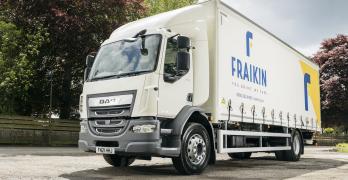Renting a vehicle with a driver, instructions on how it works
- 19/01/23
- 4 min
The principle of renting a vehicle with a driver has found its place in the market. For carriers, it can be very useful in dealing with specific circumstances such as a peak in activity, increased routes, or one-off needs. We will explain the procedure to you.

Renting a vehicle with a driver: a valuable driver for agility
Although it originated in France, the practice of renting vehicles (vans, trucks, etc.) with a driver has spread across Europe (Belgium, United Kingdom, Germany, etc.). This allows carriers to provide very flexible solutions for several scenarios that may arise in the professional context.
We naturally think of needs that can be very specific. For example, the need for a large capacity truck for businesses that typically make use of smaller vehicles. Or the need for a vehicle with a technical specificity (a crane truck for example) for a very specific application.
There is also the case where skills are not available internally, the search for vehicle rental with a driver, even temporary, therefore representing a driver for agility. There is also the possibility of having a very specific need, such as managing a peak in activity or increasing the number of routes. Depending on the circumstances, we will focus on long-term rental (with the possibility of seasonal or periodic combinations), short-term rental (from one day to one month), or even medium-term rental offers (from one month to six months). In each optional configuration, a contract sets out the rules for use and return in advance, as well as the pricing terms and conditions.
In all cases, the ability to hire a vehicle and driver allows businesses to react positively to an opportunity that may not have been foreseen. Ensuring the quality of service while freeing up time for planning, and potentially building a new revenue stream.
In general, several sectors have integrated the rental of vehicles with a driver into their uses: mass distribution, the construction industry (with its wide spectrum of economic agents, such as the transport of materials, for example), petrochemicals (oil, gas, chemicals, including hazardous materials), food processing, etc.
What are the advantages?
Whether it is a temporary situation (such as a seasonal peak) or a more constant stress on workloads, turning to renting a vehicle with a driver will guarantee that quality service is maintained for your clients – something that is all important. This offers you an adaptable way of accommodating different contracts, and giving your clients the complete service they require.
In addition, at the financial level, you are opting for a contractual and transparent solution. It is difficult to nail down specific amounts as they are likely to vary depending on the length of the rental, the type of vehicle rented, the services retained, etc. However, the main thing is that this solution avoids significant investments and capital immobilisation. You can therefore adapt to your business without modifying your cash balance. It should be noted that investing in trucks that better comply with environmental standards can also be an avenue in the quest for savings.
And if you have to consider more structural investments, that’s a good sign! This means that the increase in business has turned into real growth and that your new needs are sustainable and compatible with your business model.
The right vehicle and driver: some good practices
In a context of this nature, the advantages of renting a vehicle with a driver are numerous if a few simple rules are followed.
First of all, it is advisable to give business to a recognised rental professional, who may already be your partner for vehicles concerning long-term rentals without a driver. Thus, beyond the advice from which you may benefit, and ensure access to a wide range of recent vehicles* (light commercial vehicles, trucks, vans, speciality vehicles) with the right driver. It is difficult to find qualified drivers in the labour market, and even more so business experts, so partnering with a rental professional can help. In addition, you avoid the risk of throwing off the balance of your teams, because these drivers are regularly trained and familiar with good practices such as safety and eco-driving.
Make sure that the service provider you have chosen handles the administrative management of the vehicle and the driver, in particular the employment contract and the insurance component (important and complex in the event of pan-European activity), in order to save time and money.
*The average fleet of rental companies is twice as large as the total fleet in circulation in France (source: TLF)
Also worth reading

The domino effect of geopolitics on automotive supply chains

Transport: The promise of hydrogen

